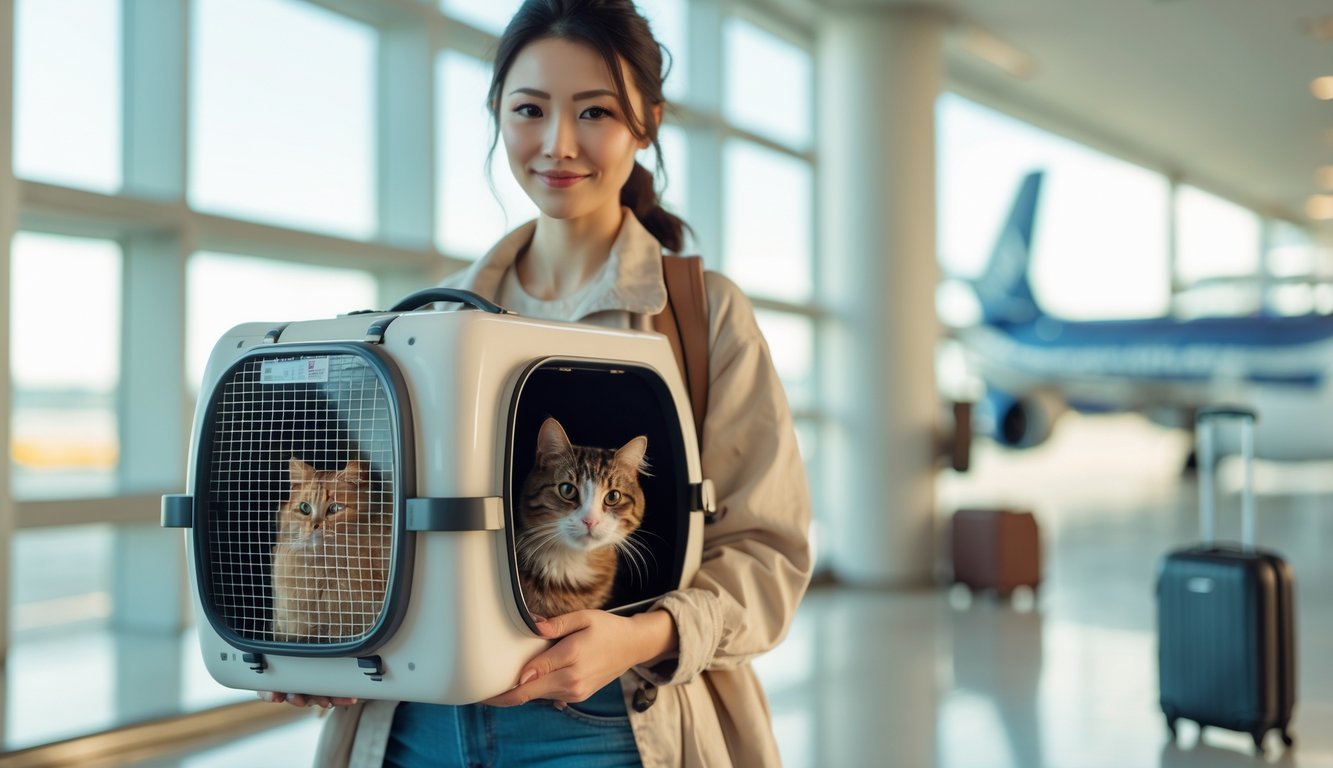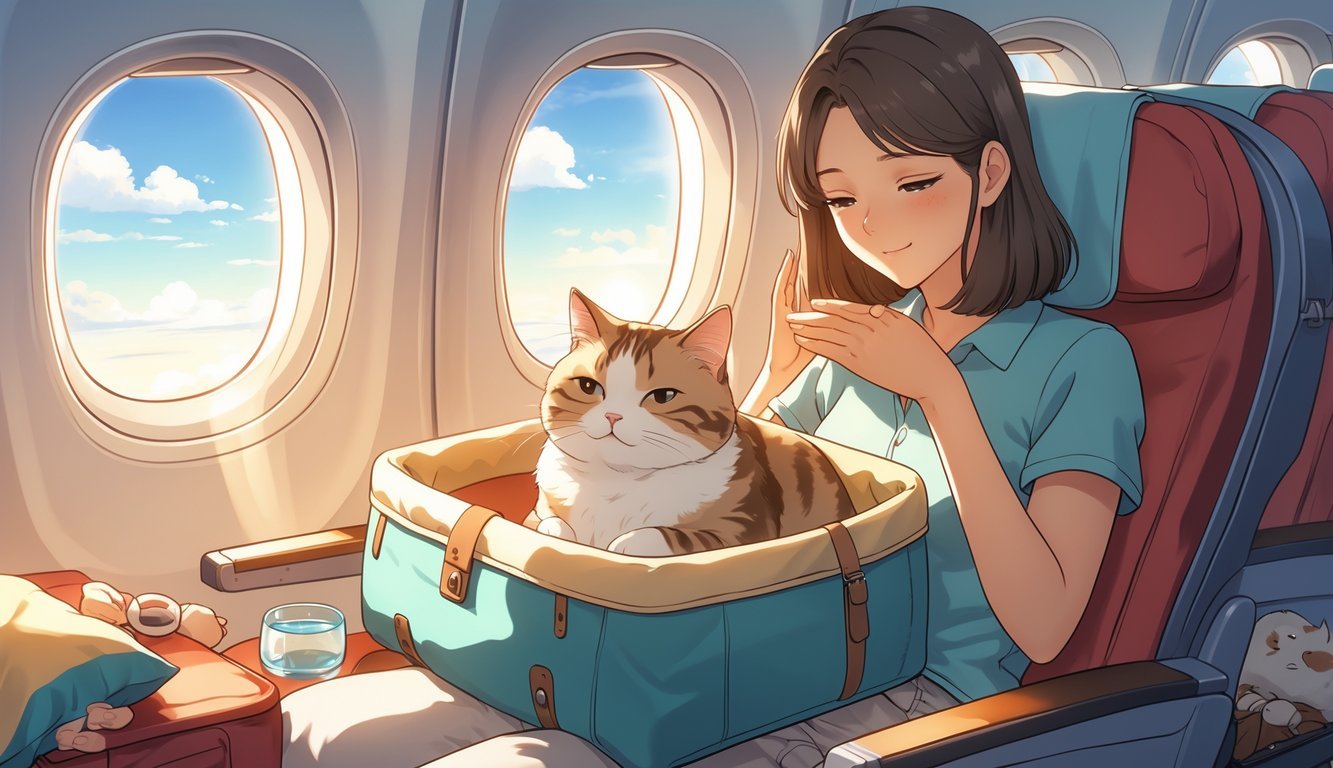PsychNewsDaily Publishers
100 Summit Drive
Burlington, MA, 01803
Telephone: (320) 349-2484
PsychNewsDaily Publishers
100 Summit Drive
Burlington, MA, 01803
Telephone: (320) 349-2484
Flying with a cat requires careful preparation, including choosing a pet-friendly airline, using an approved carrier, and ensuring hydration and comfort during the journey.

Flying with your cat can feel overwhelming, especially if it’s your first time bringing your pet on a plane. There’s a lot to think about—from picking the right airline to helping your cat stay calm in the cabin.
If you know how to prepare your cat for air travel, you’ll both feel less stressed and the trip will probably go more smoothly.
You want your cat to feel safe, secure, and cared for every step of the way. With a few thoughtful steps, you can make a travel plan that meets your cat’s needs and makes things easier for you, too.
This guide breaks down practical ways to get ready before, during, and after the flight so you both arrive with less stress.

Start by checking each airline’s pet policy when you plan to fly with your cat. Airlines don’t all treat pets the same, and the rules can change depending on your route or even the season.
Look for airlines that let cats travel in the cabin with you. Most carriers allow small pets under the seat in an approved carrier for a set fee, which usually keeps your cat more comfortable.
Check the fees—they vary a lot. Some airlines charge about $100 for in-cabin pets, but others ask for more. Knowing this ahead of time helps you avoid surprises at the airport.
Find out how many pets can fly in the cabin. Airlines often have limits, so booking early gives you a better shot at a spot.
Don’t forget about paperwork. Some airlines want health certificates or vaccination records, especially for longer or international flights. Having these ready before you go makes everything easier.

The right carrier really matters when you fly with your cat. Airlines require carriers that fit under the seat and meet safety standards, so picking an airline-approved one saves you hassle at the airport.
Go for a soft-sided carrier with mesh panels. Mesh lets fresh air in and helps your cat feel more comfortable. Good ventilation keeps your cat from getting too hot in crowded spaces.
A sturdy zipper and secure closures keep your cat safe. Many carriers have padded straps, which make them more comfortable for you to carry around.
Check your airline’s size rules before you buy a carrier. Even if it says “airline-approved,” each airline has its own requirements. Measuring ahead of time saves you from last-minute stress.
Your cat will feel calmer in a cozy, well-ventilated carrier. Toss in a familiar blanket or soft mat to help your cat relax while you focus on getting to your destination.

Feliway spray can really help your cat feel calmer when you travel. The spray mimics natural pheromones that cats release when they feel safe, making the carrier seem more familiar.
Spray the inside of the carrier, hitting the corners and bedding, about 15 minutes before you put your cat inside. This gives the spray time to settle and keeps it off your cat’s fur.
The calming effects usually last for several hours, so it’s great for flights and longer trips. If you’re traveling a long way, you can reapply every four to five hours if needed.
A lot of cat owners say this step makes travel smoother. It won’t fix everything, but it can definitely take the edge off your cat’s anxiety.

Put the carrier in a spot where your cat already likes to hang out. Leave the door open so your cat can check it out whenever they want.
Add a soft blanket, towel, or even a piece of your clothing inside. Familiar smells make the carrier more inviting and help your cat feel secure.
Drop in a few treats or toys to encourage your cat to go inside. Let your cat come and go freely at first.
After a while, start closing the door for short periods while your cat is inside. Keep these sessions brief and calm so your cat learns the carrier is safe.
If your cat seems nervous, move slowly and reward them with treats or praise. Building up good experiences with the carrier weeks before your trip will make travel day a lot less stressful.

Feed your cat a small, light meal about 4 to 6 hours before you leave. This gives them time to digest and lowers the chance of nausea during the trip.
Don’t feed your cat right before heading to the airport. A full stomach can make motion sickness worse and cause discomfort in the carrier.
Stick to their regular food—new foods before travel can upset their stomach. After eating, make sure your cat has fresh water.
Offer a small drink before you put your cat in the carrier, but don’t overdo it to avoid accidents during the flight.
Timing meals thoughtfully helps your cat feel more comfortable and reduces the risk of tummy issues while traveling.

Put a blanket or toy your cat already loves in the carrier. The familiar smell and feel can make the new environment less intimidating.
You can use a blanket your cat sleeps on or a favorite toy. These items carry your cat’s scent, which can help lower stress during travel.
Even a small piece of your clothing can help. Just make sure the blanket or toy doesn’t crowd the space—your cat should still have room to move.
A soft layer makes the carrier more comfortable for resting during the flight. This little step can really help your cat feel safer.

Flying can be dehydrating for both you and your cat. Cats might not drink as much when they’re stressed, so bringing a small water bottle lets you offer water when you can.
Pick a spill-proof travel bottle made for pets. These make it easy to give your cat a sip without making a mess.
Offer water during layovers or after you land. If your cat isn’t interested, try using the same water they drink at home for a familiar taste.
Keep the bottle handy in your bag so you can refill it and make sure your cat stays hydrated throughout the trip.

Try to book a direct flight when you travel with your cat. Less time in airports and on planes means less stress for both of you.
Your cat will spend less time in the carrier, which makes the trip easier. Connecting flights often mean rushing through terminals and waiting at gates—definitely not your cat’s idea of fun.
A direct route also lowers the risk of delays or lost baggage. You’ll feel better knowing your cat stays with you the whole time.
Even if a direct flight costs a bit more, the comfort and reduced stress for your cat can make it worth it.

When you book your seat, try to pick a spot away from the bathrooms or galley. These areas get loud and busy, which can make your cat more anxious.
A quieter area helps your cat feel safer. If you can, ask for a seat closer to the front of the cabin.
The front is usually quieter than the back, where engine noise and passenger movement are more noticeable. It’s a small change, but it can really help your cat’s comfort.
Let the airline staff know you’re flying with a cat. Sometimes they can help you find a quieter spot if seats are available.
A quiet seat won’t block out all noise, but it can cut down on sudden sounds that might startle your cat. Every little bit helps make the flight smoother.

Your cat might show stress in ways that are easy to miss, and new surroundings can make these behaviors even stronger. If you know what to look for and understand how cats usually react to change, you’ll have an easier time helping your pet stay calm.
Cats often show stress through body language and vocal sounds. You might notice excessive meowing, growling, or hissing. Some cats just get really quiet.
Watch for physical signs like ears pinned back, tail flicking, or dilated pupils. Heavy breathing or panting can also show your cat feels anxious.
Stress can change your cat’s behavior. Your cat might refuse food or water, hide in the carrier, or scratch at the sides. Some cats drool or even vomit if they’re really anxious.
It helps to watch your cat before the trip so you know what’s normal. That way, you’ll spot changes quickly while you’re traveling.
If your cat seems extremely distressed, ask your vet about safe calming aids or other options.
Cats are creatures of habit, so sudden changes can throw them off. The airport’s noise, bright lights, and crowds can be overwhelming.
On a plane, your cat might get restless in the small space or from all the new smells. Some will try to hide deeper in the carrier, while others might pace or scratch.
If your cat has traveled before, they might handle things a bit better. Cats who are used to car rides sometimes adjust faster than those who rarely leave home.
Bringing familiar items, like a blanket or toy, can help. The scent of home gives your cat comfort and helps them feel a little more secure.

You can make things easier by knowing what to expect at security and using airport spaces that are pet-friendly. Bringing the right gear and planning breaks for your cat can make the airport feel a bit more manageable.
Security at the airport can feel pretty overwhelming, right? Being prepared definitely helps, especially when you’re traveling with a cat.
You’ll have to take your cat out of the carrier because the carrier needs to go through the X-ray machine. It’s a weird moment, honestly.
Bring a harness or leash so you can keep your cat close while you hold them in your arms. That little bit of extra control makes a huge difference.
Pick a harness that fits snugly but isn’t too tight. Try it out at home before the trip—no one wants surprises at the checkpoint.
If you practice with the harness ahead of time, your cat will probably feel less freaked out when it’s time to carry them through security.
Keep your boarding pass and documents in a pocket you can reach easily. That way, you’re not fumbling while you hold your cat.
A crossbody bag or a waist pouch works great since it keeps your hands free. I mean, you’ll need them.
If your cat hates loud noises, you might want to go through security during quieter times. Early mornings or midweek flights usually mean fewer people.
Less chaos means a calmer cat, and honestly, a calmer you.
These days, a lot of airports actually set up spaces just for pets. You’ll usually spot pet relief areas on airport maps or signs if you know where to look.
You’ll find grass patches, waste bags, and trash bins in these areas. They make it so much easier when your cat needs a break.
Some airports even have quieter waiting zones or lounges. Sure, lounges might cost a bit extra, but sometimes you just want a little more space and less noise—especially if your cat gets anxious around crowds.
Try tossing a small blanket or towel into your carry-on. If you end up waiting at the gate, laying out something familiar can make the carrier cozier and help your cat chill out a bit.
I’d also recommend packing a small travel kit. Toss in wipes, extra bags, and a collapsible water bowl so you’re ready for spills or if your cat needs a quick drink—no frantic searching for supplies required.